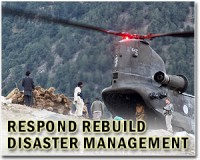 |
Sendai, Japan (AFP) April 28, 2011 Japanese workers tackling the Herculean task of clearing millions of tonnes of debris from last month's earthquake and tsunami also face health risks from asbestos and dioxins. The destruction wrought by the March 11 calamity is so enormous that just removing the rubble is expected to take years. Clearing away an estimated 25 million tonnes of wreckage is a vital step in allowing victims to move on after the disaster, which left more than 14,500 dead and 11,500 missing in Japan's worst catastrophe since World War II. "This is an enormous task," said Matoko Iokibe, chairman of the Reconstruction Design Council which advises the prime minister, and who suggested the rubble could be turned into landscaped hills. "In normal times people would be able to use these parks for recreation," he said. "During disasters, they would be used as evacuation zones." Most workers now struggling through the sea of toppled trucks, twisted steel and tortured concrete wear face masks to protect themselves as best they can from inhaling toxic and carcinogenic asbestos-laden dust. "The biggest concerns are dirt, sand and building dust that can be inhaled and cause abnormalities in the lungs," said Sendai city official Tetsuo Ishii. "When workers tear down buildings, a lot of dust comes out, and there are concerns about asbestos," said Ishii. The tiny fibres of asbestos, a material used for decades for insulation and fireproofing before it was banned in much of the world and Japan, are easily inhaled and can cause lung cancer. The Yomiuri Shimbun newspaper said the government was setting up a panel to ensure workers are protected and that officials would monitor asbestos levels, with a surge of volunteers expected during the Golden Week holiday which starts Friday. Another official in Sendai city, the capital of hardest-hit Miyagi prefecture, said the thousands of tonnes of wooden debris also posed a threat. "There are more than 30,000 tonnes of wooden debris, but... it can produce a lot of dioxin if it's simply burned," said Yoichi Kobayashi, deputy director-general of Sendai's environment department. "It is important to incinerate the wood in a special facility." Open burning of trash is one of the leading sources of dioxins -- highly toxic pollutants that occur in the environment. The city will recycle tyres, home appliances and scrap metal while uprooted pine trees will be sent to wood pulp plants, he said. "We are calling for private cement companies to recycle the unburnable, such as concrete debris and ceramic roof tiles," Kobayashi said. When the government led by Prime Minister Naoto Kan approved its first extra disaster budget last week, it allocated more than 350 billion yen ($4.3 billion) for disposal of the rubble. Sendai has deployed more than 1,000 workers to clear extensively damaged areas of the city but expects it will take at least four months just to remove debris and three years to dispose of it all. Three beach parks in the coastal city are being used as disposal sites for the rubble, with an endless stream of trucks depositing piles of muddy mattresses, tangled steel and other debris. Nearby, as Japanese troops scoured the area for bodies of tsunami victims, farmer Kenichi Seto, 52, sorted through the wrecked frames of his greenhouses. He expects it will take at least a year to clear the rubble from his land. "There's no way we could do this all by hand, so we had big machinery come in first. Now we are sorting through the leftovers by ourselves, although we don't even know if this place can be farmed again," he said. Seto and his 80-year-old mother salvaged usable items, such as aluminium frames, from the sandy land scattered with broken dishes, papers and plastic sheets where their house once stood. "This place is much cleaner now compared with what it was on the day after the tsunami," Seto said as he petted one of his dogs. "I couldn't even see out so far due to huge amounts of debris blocking the view." His mother Aki said: "There used to be four huge tanks of heavy oil over there. The tsunami carried two of them to the west of the next village and another even further west." But, despite the fact that their 250 hectares (620 acres) of farmland are now soaked in seawater and heavy oil, the elderly woman said she had no intention of leaving for good despite her son's reservations. "You've got to come back to where you live," she said.
Share This Article With Planet Earth
Related Links Bringing Order To A World Of Disasters A world of storm and tempest When the Earth Quakes
 Japan imperial couple visit tsunami zone
Japan imperial couple visit tsunami zoneSendai, Japan April 27, 2011 Japan's imperial couple on Wednesday made their first visit to the country's tsunami-ravaged northeast, where they were cheered by hundreds of elated well-wishers. Emperor Akihito and Empress Michiko, seen as living symbols of national unity, comforted survivors of the March 11 earthquake and tsunami at evacuation centres in a devastated port town and in nearby Sendai city. Meeting evacu ... read more |
|
| The content herein, unless otherwise known to be public domain, are Copyright 1995-2010 - SpaceDaily. AFP and UPI Wire Stories are copyright Agence France-Presse and United Press International. ESA Portal Reports are copyright European Space Agency. All NASA sourced material is public domain. Additional copyrights may apply in whole or part to other bona fide parties. Advertising does not imply endorsement,agreement or approval of any opinions, statements or information provided by SpaceDaily on any Web page published or hosted by SpaceDaily. Privacy Statement |